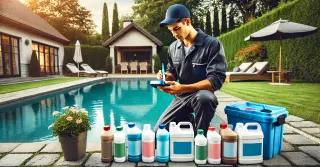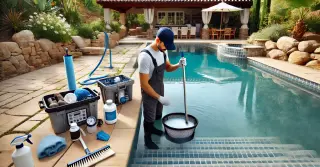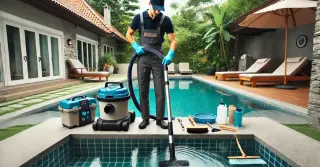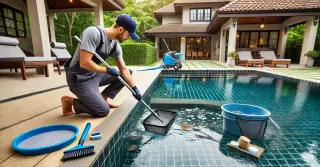Pool Chemical Balance Duluth GA

Keeping your pool's chemical balance in check is essential for a safe and enjoyable swimming experience. Balanced chemicals inhibit algae and bacteria, ensure clear water and protect pool surfaces and equipment.
- Optimal pH Balance: Your pool's pH level reflects its acidity or alkalinity. Optimal pH levels range from 7.2 to 7.6. If the pH is too low, the water becomes acidic, which can cause skin irritation and corrosion of pool equipment. Alkaline water from high pH causes cloudiness and scaling. Consistently testing and adjusting pH levels is crucial for comfort and safety.
- Monitoring Chlorine Levels: Chlorine is a key component in pool sanitation, killing bacteria, algae, and other harmful microorganisms. The proper chlorine level is between 1-3 ppm. Low chlorine levels cause unsanitary water, with bacteria and algae proliferating. Excessive chlorine leads to skin and eye irritation and produce a strong chlorine odor. Regularly testing and adjusting chlorine levels maintains sanitation and comfort.
Optimal Alkalinity LevelsTotal alkalinity plays a vital role in pool water balance. Alkalinity stabilizes pH levels, helping to prevent drastic changes in pH. Proper total alkalinity levels range from 80 to 120 ppm.
- Preventing pH Swings: Correct alkalinity levels ensure stable pH, preventing rapid pH shifts that cause skin irritation and surface damage. If alkalinity is too low, pH levels can fluctuate wildly, making balance maintenance challenging. Excessive alkalinity results in cloudy water and scaling. Consistently monitoring and adjusting alkalinity levels is essential for maintaining a stable and balanced pool.
- Calcium Hardness Control: Calcium hardness refers to the amount of dissolved calcium in the pool water. Optimal calcium hardness levels are between 200-400 ppm. Insufficient calcium causes corrosive water, damaging surfaces and equipment. High calcium levels lead to scaling and cloudy water. Regularly testing and adjusting calcium hardness is essential for pool protection and clear water.
Safe Handling of Pool ChemicalsProper handling and storage of pool chemicals is essential for both safety and effectiveness. Keep chemicals in a cool, dry location, away from direct sunlight, children, and pets. Always follow the manufacturer's instructions for dosing and application.
- Proper Chemical Measurement and Mixing: Accurately measuring pool chemicals is crucial for maintaining balance. Inaccurate dosing can imbalance chemicals and harm water quality. Always use a clean, dry measuring cup or scoop and never mix chemicals directly with each other. If needed, mix chemicals in water as per instructions.
- Chemical Reaction Awareness: Some chemicals can react dangerously when combined. For example, chlorine and acid should never be mixed. Knowing these interactions helps prevent accidents and ensures safe handling. Store chemicals separately and handle each with care to prevent harmful reactions.
Ensuring the right chemical balance in your pool is essential for a safe, clean, and enjoyable swimming environment. By consistently testing and adjusting pH, chlorine, alkalinity, and calcium, you ensure optimal water quality.
Proper chemical use and storage improve the safety and longevity of your pool.




